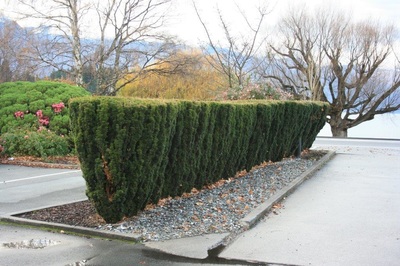Various Shrubs
Junipers
Pictured are low-growing junipers common in landscaping. Height of these plants ranges from several inches to 2 feet in height. They are great ground-covering plants that help to control erosion or cover areas with poor soil. Larger varieties of junipers than those pictured exist in sizes up to 6 feet in height or even towards the largest size of 10 feet in height. Juniper have a scent that is quite reminiscent of pine, but not as intense.
Yews
Yews are a great option for hedges and screens. There are seven species of yew within the Taxus genus, but there are many, many different hybrid varieties created from these seven species. Different types of yews do better for different hedging needs; some grow large/tall, others grow dense and are best kept short. Caution for families with young children: certain parts of the yew plant are toxic if ingested.
Arborvitae
Although most commonly used for hedges/shrubs, arborvitae can grow to be quite large trees; there are larger varieties and dwarf varieties of the arborvitae, depending on your needs both can serve many functions. They are climate-versatile and don't take long to grow. The globe arborvitae maintains its circular shape without trimming and will only get to be about 5 feet tall maximum.
Boxwoods
Boxwoods are one of the most popular shrubs available for landscaping in the US. They are easy to care for and come in shapes/sizes that are adaptable to many styles of landscaping. There are more than 140 types of boxwoods available commercially from the over 200 types of boxwood varieties existing today. Types of boxwood shrubs can vary in growth form, growth rate, leaf shape, and overall plant hardiness.












